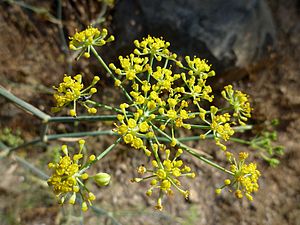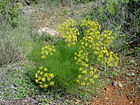Note: This is a project under development. The articles on this wiki are just being initiated and broadly incomplete. You can Help creating new pages.
Difference between revisions of "Foeniculum vulgare - Misreya"
Chaithrika (talk | contribs) (+Common names) |
|||
| (15 intermediate revisions by 2 users not shown) | |||
| Line 1: | Line 1: | ||
| − | [[File: | + | [[File:FOENICULUM VULGARE - AGUDA - IB-112 (Fonoll).JPG|thumb|right|''Misreya'', ''Fennel '']] |
| − | ''' | + | '''Foeniculum vulgare''' is a flowering plant species in the carrot family. It is a hardy, perennial herb with yellow flowers and feathery leaves. It is indigenous to the shores of the Mediterranean but has become widely naturalized in many parts of the world, especially on dry soils near the sea-coast and on riverbanks. |
| + | ==Uses== | ||
| + | {{Uses|Respiratory congestion}}, {{Uses|Cough remedies}}, {{Uses|Gastric problem}}, {{Uses|Acid stomach}}, {{Uses|Gout}}, {{Uses|Cramps}}, {{Uses|Colic}}, {{Uses|Spasms}}. | ||
| − | == | + | ==Parts Used== |
| + | {{Parts Used|Leaves}}, {{Parts Used|Roots}}, {{Parts Used|Stem}}, {{Parts Used|Fruits}} | ||
| − | + | ==Chemical Composition== | |
| + | The major constituent of fennel oil is anethole. Other constituents include alpha pinene, beta myrcene, beta pinene, bitter fenchone, camphene, estragole (methyl-chavicol), fenchone, limonene, p-cymen, and safrole<ref name="chemical composition"/> | ||
| − | Fennel is | + | ==Common names== |
| − | + | {{Common names|kn=Dodda sompu|ml=Preumjirakam|sa=Misreya, Madhurika|ta=Sompu|te=Peddajilakarra|hi=Moti saunf|en=Fennel, Sweet fennel}} | |
| + | |||
| + | ==Properties== | ||
| + | Reference: Dravya - Substance, Rasa - Taste, Guna - Qualities, Veerya - Potency, Vipaka - Post-digesion effect, Karma - Pharmacological activity, Prabhava - Therepeutics. | ||
| + | ===Dravya=== | ||
| + | |||
| + | ===Rasa=== | ||
| + | Tikta (Bitter), Katu (Pungent), Madhura (Sweet) | ||
| + | ===Guna=== | ||
| + | Laghu (Light), Snigda (heavy) | ||
| + | ===Veerya=== | ||
| + | Ushna (Hot) | ||
| + | ===Vipaka=== | ||
| + | Madhura (Sweet) | ||
| + | ===Karma=== | ||
| + | |||
| + | ===Prabhava=== | ||
| + | |||
| + | ==Habit== | ||
| + | {{Habit|Herb}} | ||
| + | |||
| + | ==Identification== | ||
| + | ===Leaf=== | ||
| + | {{Leaf|Simple|40 cm long|They are finely dissected, with the ultimate segments filament-like, about 0.5 mm wide}}<ref name="Leaf"/> | ||
| + | |||
| + | ===Flower=== | ||
| + | {{Flower|Unisexual|5–15 cm wide|Yellow|5-20|The flowers are produced in terminal compound umbels}} | ||
| + | |||
| + | ===Fruit=== | ||
| + | {{Fruit|Dry seed|4–10 mm long|This fruit is what the plant is better known for, and is usually mistakenly called seed|With hooked hairs|Many}} | ||
| + | |||
| + | ===Other features=== | ||
| + | |||
| + | ==List of Ayurvedic medicine in which the herb is used== | ||
| + | * [[Vishatinduka Taila]] as ''root juice extract'' | ||
| + | |||
| + | ==Where to get the saplings== | ||
| + | ==Mode of Propagation== | ||
| + | {{Propagation|Seeds}}, {{Propagation|Cuttings}}. | ||
| + | |||
| + | ==How to plant/cultivate== | ||
| + | An easily grown plant, it succeeds in most soils but prefers a sunny dry position.<ref name="How to plant/cultivate"/> | ||
| + | |||
| + | ==Commonly seen growing in areas== | ||
| + | {{Commonly seen|Dry soil}}, {{Commonly seen|Sea coast}}, {{Commonly seen|Riverbanks}}. | ||
| + | |||
| + | ==Photo Gallery== | ||
| + | <gallery class="left" caption="" widths="140px" heights="140px"> | ||
| + | File:FOENICULUM VULGARE - AGUDA - IB-112 (Fonoll).JPG|A Torà (Segarra - Catalunya) | ||
| + | File:FOENICULUM VULGARE - AGUDA - IB-209 (Fonoll).JPG|A Torà (Segarra - Catalunya) | ||
| + | Image:Foeniculum vulgare.jpg|Fenkoli | ||
| + | Image:Foeniculum vulgare.JPG|Habitus | ||
| + | Image:Starr_030628-0083_Foeniculum_vulgare.jpg|Habit | ||
| + | File:Foeniculum vulgare prg 1.jpg|Habitus | ||
| + | File:Foeniculum vulgare prg 2.jpg|Habitus | ||
| + | File:Foeniculum-vulgare-habitus.jpg|Habitus | ||
| + | </gallery> | ||
| + | |||
| + | ==References== | ||
| − | + | <references> | |
| + | <ref name="chemical composition">[https://www.sigmaaldrich.com/life-science/nutrition-research/learning-center/plant-profiler/foeniculum-vulgare.html Constituents]</ref> | ||
| − | + | <ref name="Leaf">[http://www.flowersofindia.net/catalog/slides/Fennel.html Plant description]</ref> | |
| − | |||
| − | |||
| − | + | <ref name="How to plant/cultivate">[https://www.pfaf.org/user/plant.aspx?LatinName=Foeniculum+vulgare Cultivation details]</ref> | |
| − | |||
| − | |||
| − | <ref name=" | ||
</references> | </references> | ||
| − | == | + | ==External Links== |
| − | + | * [http://www.planetayurveda.com/library/mishreya-foeniculum-vulgare Foeniculum vulgare on planet ayurveda] | |
| − | *[https:// | + | * [https://www.cabi.org/isc/datasheet/24271 Foeniculum vulgare on Invasive Species Compendium] |
| + | * [http://www.missouribotanicalgarden.org/PlantFinder/PlantFinderDetails.aspx?taxonid=275990 Foeniculum vulgare on missouri garden] | ||
[[Category:Herbs]] | [[Category:Herbs]] | ||
| + | [[Category:Apiaceae]] | ||
Latest revision as of 16:27, 23 October 2020
Foeniculum vulgare is a flowering plant species in the carrot family. It is a hardy, perennial herb with yellow flowers and feathery leaves. It is indigenous to the shores of the Mediterranean but has become widely naturalized in many parts of the world, especially on dry soils near the sea-coast and on riverbanks.
Contents
- 1 Uses
- 2 Parts Used
- 3 Chemical Composition
- 4 Common names
- 5 Properties
- 6 Habit
- 7 Identification
- 8 List of Ayurvedic medicine in which the herb is used
- 9 Where to get the saplings
- 10 Mode of Propagation
- 11 How to plant/cultivate
- 12 Commonly seen growing in areas
- 13 Photo Gallery
- 14 References
- 15 External Links
Uses
Respiratory congestion, Cough remedies, Gastric problem, Acid stomach, Gout, Cramps, Colic, Spasms.
Parts Used
Chemical Composition
The major constituent of fennel oil is anethole. Other constituents include alpha pinene, beta myrcene, beta pinene, bitter fenchone, camphene, estragole (methyl-chavicol), fenchone, limonene, p-cymen, and safrole[1]
Common names
| Language | Common name |
|---|---|
| Kannada | Dodda sompu |
| Hindi | Moti saunf |
| Malayalam | Preumjirakam |
| Tamil | Sompu |
| Telugu | Peddajilakarra |
| Marathi | NA |
| Gujarathi | NA |
| Punjabi | NA |
| Kashmiri | NA |
| Sanskrit | Misreya, Madhurika |
| English | Fennel, Sweet fennel |
Properties
Reference: Dravya - Substance, Rasa - Taste, Guna - Qualities, Veerya - Potency, Vipaka - Post-digesion effect, Karma - Pharmacological activity, Prabhava - Therepeutics.
Dravya
Rasa
Tikta (Bitter), Katu (Pungent), Madhura (Sweet)
Guna
Laghu (Light), Snigda (heavy)
Veerya
Ushna (Hot)
Vipaka
Madhura (Sweet)
Karma
Prabhava
Habit
Identification
Leaf
| Kind | Shape | Feature |
|---|---|---|
| Simple | 40 cm long | They are finely dissected, with the ultimate segments filament-like, about 0.5 mm wide |
Flower
| Type | Size | Color and composition | Stamen | More information |
|---|---|---|---|---|
| Unisexual | 5–15 cm wide | Yellow | 5-20 | The flowers are produced in terminal compound umbels |
Fruit
| Type | Size | Mass | Appearance | Seeds | More information |
|---|---|---|---|---|---|
| Dry seed | 4–10 mm long | This fruit is what the plant is better known for, and is usually mistakenly called seed | With hooked hairs | Many | {{{6}}} |
Other features
List of Ayurvedic medicine in which the herb is used
- Vishatinduka Taila as root juice extract
Where to get the saplings
Mode of Propagation
How to plant/cultivate
An easily grown plant, it succeeds in most soils but prefers a sunny dry position.[3]
Commonly seen growing in areas
Dry soil, Sea coast, Riverbanks.
Photo Gallery
References
External Links
- Ayurvedic Herbs known to be helpful to treat Respiratory congestion
- Ayurvedic Herbs known to be helpful to treat Cough remedies
- Ayurvedic Herbs known to be helpful to treat Gastric problem
- Ayurvedic Herbs known to be helpful to treat Acid stomach
- Ayurvedic Herbs known to be helpful to treat Gout
- Ayurvedic Herbs known to be helpful to treat Cramps
- Ayurvedic Herbs known to be helpful to treat Colic
- Ayurvedic Herbs known to be helpful to treat Spasms
- Herbs with Leaves used in medicine
- Herbs with Roots used in medicine
- Herbs with Stem used in medicine
- Herbs with Fruits used in medicine
- Herbs with common name in Kannada
- Herbs with common name in Hindi
- Herbs with common name in Malayalam
- Herbs with common name in Tamil
- Herbs with common name in Telugu
- Herbs with common name in Sanskrit
- Herbs with common name in English
- Habit - Herb
- Index of Plants which can be propagated by Seeds
- Index of Plants which can be propagated by Cuttings
- Herbs that are commonly seen in the region of Dry soil
- Herbs that are commonly seen in the region of Sea coast
- Herbs that are commonly seen in the region of Riverbanks
- Herbs
- Apiaceae








